
Wine Culture and Information since 2002 - Volume 22
 Wine Culture and Information since 2002 - Volume 22 |
|
Issue 25, December 2004 |
Contents |
|
|
To Age or Not To Age Wines? |
|
Among the many letters we receive, there are lots of readers asking for advices or opinions about the longevity of the wine they own. It seems our readers, besides being sincere lovers of the beverage of Bacchus and always interested in a nice glass of wine, keep in their houses many bottles. Many of them have purchased these bottles both because of the exceptionality of the vintage as well as for the good occasion offered by a circumstance. Others received precious and valuable bottles as a gift, sometimes these bottles are wines inherited from relatives or simply part of the family ”heritage”. Many readers ask themselves about the conditions of the bottle they have always seen in their kitchen since they were kids and are often tempted to uncork, attracted both by curiosity and the hope the wine is still good. Moreover it seems many of those wines have been purchased in occasion of special events, such as the birth of a baby or the celebration of a wedding, always with the intent of uncorking that very same bottle many years later to celebrate the anniversary. It is however understandable to those bottles are recognized high affective meanings which remind of a particular circumstance, a specific event, a happy moment of live. For this reason the uncorking of the “special” bottle is postponed just because of the memory it represents, however the fear that wine, as years go by, loses its best qualities and therefore it is not drinkable anymore, is pretty strong. The fear that bottle, after many years spent inside a house, maybe kept in a not properly optimal way, makes people believe too many years have passed and it is not probably worth uncorking it anymore. If it is true not all people have rooms suited for the keeping of wine, in particular the ones who live in apartments of condominiums, it is also true most of the times even the most elementary precautions for a good keeping are being neglected. Often forgot in a shelf, exposed to light and to strong smells of kitchen, or hidden among other bottles in some furniture of the house, most of the times kept in vertical position, these bottles certainly do not have many possibilities to live long. The keeping of a bottle of wine requires the availability of good conditions of temperature, light and humidity, sometimes even the best conditions do not ensure a good longevity to wine, at least, not to all wines. Of course the lacking of such requisites drastically decreases the hope for a good aging of the wine in a bottle. The aging of wine in bottle is not determined by keeping conditions only. There are other factors which strongly influence keeping, such as vintage, variety of grape, area of production and, last but not the least, the way that wine was produced. White wines, with the exception of few, lose their best qualities after two or three years and the same can be said for rose wines. Even the longevity of sparkling wines is pretty short: after disgorgement begins their inexorable decay and after two or three years their qualities of freshness are seriously compromised in favor or a higher complexity not always appreciated by consumers. There is the general idea red wines are always and however suited for long aging times in bottle: indeed for most of the wines found in the market it is better to drink them within two or three years from vintage. Thanks to high percentage of sugar or alcohol, sweet and fortified wines are the ones which can stand better than others to the risks of a bad keeping, however when good conditions cannot be ensured, it is good not to exaggerate. In other words, the famous Italian saying “the more a wine ages the more it gets good” is not always true and however it is not valid for all wines. Wines suited for long aging times in bottle must be made with this specific purpose, provided they are however kept in places offering optimal conditions for keeping. When it is being decided to keep a bottle at home, that is a place which rarely offers ideal conditions, it is good to remember periods longer than three years are always to be considered as a risk. Of course we are not trying do discourage our readers by suggesting them not to keep wines at home. Indeed we are trying to have our readers remember the keeping of a wine is regulated by specific conditions which are not always possible to have in our houses. With the exception of understandable reasons of sentimental or affective nature for the bottles kept at home, most of the times the uncorking is postponed because of the fear the occasion is not sufficiently important or right. The uncorking of that bottle will be continuously postponed while believing time will however make that wine better. Most of the times, when finally the bottle is being uncorked, disappointment is the most common feeling. The magic of a special moment waited for years is vanished by a wine which is not in good conditions anymore because of a bad keeping or because it was not suited for aging. Saved the case you have a cellar suited for the aging of wines, our advice is to think twice before making the decision of keeping a wine. In case you have no cellar, the best advice we can give is to uncork the bottle when it is in its best conditions of appreciation and before it gets transformed into a disappointment. In other words, like Latins taught us, “live the moment” or in their words, “carpe diem”!
|
||||
MailBox |
|
In this column are published our reader's mail. If you have any comment or any
question or just want to express your opinion about wine, send your letters to
our editorial or fill in
the form available at
our site.
|
| I like white wines and I frequently invite my friends for a barbecue. Every time I offer white wines they all tell me that with barbecue it would be better to have red wines. Is it a mistake to offer white wines in such occasions? |
| Keith Carey -- Mendocino, California (USA) |
| Despite there are many theories about food-wine matching, often based on chemical and sensorial principles, it is good to remember these theories cannot take the place of personal taste. Enogastronomical matching - whose purpose is to confront it with the taste of people and to provide satisfaction - cannot be seen as an indisputable rule. Moreover, it should be remembered that sometimes wine-food matching is determined by traditional and cultural principles and that, apparently, do not have anything in common with science. Let's consider the famous saying ”fish goes with white wine” and we can understand common beliefs, even those having traditional roots, are usually considered as indisputable rules. Likewise it is believed meat must be necessarily matched to red wine. Indeed none of these two rules is absolute, because it is so evident fish can be well matched to red wines, as well as meat can be matched to white wine. Once again the problem is about common beliefs: red wines are always and however considered full bodied - therefore to be matched to a robust food such as meat - and white wines considered as delicate. This can be true only in general terms because there are very delicate red wines and full bodied white wines. Therefore we do not think offering white wines with barbecue can be a mistake: in case the wine was chosen according to how the meat was prepared, even white wines represents a good choice. Likewise not all red wines are good for barbecue, because, in case they are too robust, they could cover the organoleptic qualities of food, or just being useless in case they have not much body. The same can be said for any type of wine and for any type of food. |
| I read in your magazine about the difference between classic method and Charmat sparkling wines, and according to what I read, it seems in your opinion classic method sparkling wines are better. I had some Charmat sparkling wines and I found them very good, sometimes even better than many classic method sparkling wines. How can you explain this? |
| Delaney Figgins -- New York (USA) |
| Quality in wines is determined by many factors and the production technique is one of them. The same is true for sparkling wines. The adoption of a specific technique - classic method or Charmat method - is not enough in order to ensure a high quality result in case all the other factors were neglected. Area, grapes, climate, meteorological condition of the year, the intervention of man and the production technique, are all elements contributing to the making of a quality wine. Not all grapes are suited for the production of a sparkling wine and, in particular, not all grapes are suited for classic method technique. There are grapes capable of making very good Charmat method sparkling wines and mediocre classic method ones and vice versa, therefore the adoption of classic method does not necessarily mean making a better sparkling wine. It is however undeniable the results obtained with classic method are better, for example, in the quality of perlage and the complexity of aromas. On the other hand, sparkling wines produced with the Charmat method have a better aromatic freshness. The adoption of specific techniques - as well as specific grapes - does not ensure a high quality wine: it just contributes to obtain this result and represents one of the many factors whose efficiency is determined by its use. That's why there are excellent classic method sparkling wines and mediocre classic method sparkling wines. The same considerations are valid for Charmat sparkling wines as well as for any other style of wine. |
SicilyThe largest island of Italy is an enchanting territory rich in history, art and culture, as well as a region with deep and ancient enological traditions, land of great and renowned wines |
|
Land of sun and sea, as well as very ancient traditions and cultures, Sicily - the largest Italian island - is a region among the richest in history and art, a place in which many of the great civilizations of the past met. Sicily is also a land which enchants the visitors with countless natural beauties of which is rich, with its aromas, the variety of cooking and - last but not the least - the charm of its wines. In these places are being made famous wines such as the majestic Marsala - a historical and extraordinary wine which should deserve a better consideration - the aromatic Passito di Pantelleria and Malvasia delle Lipari, without forgetting about Moscato di Noto and Moscato di Siracusa, as well as full bodied red wines and interesting white wines. These wines, responsible for the rebirth of Sicilian enology, have made famous the grapes used for their production: Grillo, Catarratto, Inzolia, Muscat of Alexandria or Zibibbo, Malvasia and Nero d'Avola are the names of some of the most renowned grapes cultivated in Sicily. Wine and vine have accompanied the history of Sicily since its very beginning up to recent times. It is believed wild vines were present in Sicily far earlier than Greeks came to the island and many grapes - now considered as autochthonous - were introduced by Phoenicians. It is likely viticulture was introduced in the island during the eighth century B.C. by the first Greek colonizers therefore setting the beginning of the future wealth for Sicilian enology. Greeks introduced their techniques, such as pruning, cultivation of low trained vines and varietal selection, radically changing the local habits of allowing the vine to a spontaneous growth which, thanks to the particular environmental and natural conditions, was however capable of giving abundant yields. Despite Greeks contributed to the development of wine making in the island, archaeological findings proved the consumption of wine were common since the seventeenth century B.C., however Greeks significantly contributed to the development of viticulture and enology in Sicily.
Since Roman times, wines from Sicily were among the most famous ones of the ancient world, they were largely exported and very appreciated in every place. At those times one of the most famous Sicilian sweet wine was Mamertino, very appreciated by noble social classes and it seems it was the favorite wine of Julius Caesar. Among other famous wines of that time are also mentioned Potulanum, Tauromenitanum e Haluntium. In later times, Christianity - in Sicily as well as in other part of Europe - by means of monastical settlements, played a fundamental role in the development of enology. During this period - from 585 to 872, which corresponded to the Byzantine domination - more than the half of the Sicilian lands became properties of religious communities, for which vine and wine were essential for the celebration of the mass. During the domination of Arabs (872-1061), wine production of the island faced a period of decay: it will only with the advent of Normans (1061-1194) and in later times, of Swabians (194-1266) that Sicilian enology showed signs of reprise. Sicilian wine continued its development with Aragoneses (1288-1512) and the result was the reprise of exports. During this period viticulture contributed to the improvement of economic conditions in Sicily. During Bourbon times the wine mainly produced was very alcoholic and it was usually destined for giving structure to other wines. It will be only at the end of 1700's, precisely in 1773, to record one of the most significative events in the history of Sicilian wine. This historical event was characterized by a young English merchant that with his intuition, as well as his commercial skill, contributed to the birth of one of the most renowned and important wines of Italy: Marsala. John Woodhouse - this is the name of the enterprising English merchant - after having tried the wine produced in Marsala, realized it could compete with the famous and uncontested wines from Jerez and Port - two wines which made many English merchants rich - and decided to send some pipes to England. It was a striking success which represented the commercial fortune of Woodhouse and with him the fortune of Sicilian enology. During 1800's, also thanks to the celebrity of Marsala, wine production in Sicily had a large development and the trade of wine become one of the main factors for local economy. It was in this period the historical and prestigious wineries in Sicily were established: Duca di Salaparuta (1824), Florio (1836), Amodeo (1837), Rallo (1860), Curatolo Arini (1875), Carlo Pellegrino (1880) and Lombardo (1881). The development of Sicilian viticulture during the 1800's was mainly concentrated in the Etnean area and in 1880 Catania was the province in Sicily having the largest acreage destined to viticulture with about 92.000 hectares (227,336 acres) and a production of wine of about one million hectoliters (about 835,000 barrels). The production of wine in the area of Catania was so important that for its transportation was also constructed a railway, which connected the port of Riposto and from there the wine was shipped to other countries. This flourishing period was interrupted in 1881 when phylloxera destroyed vineyards followed in 1888 with the breaking of the commercial agreement with France therefore causing a strong decrease in exports. The recovery of vineyards destroyed by phylloxera lasted more than half a century and ended during the 1950's. During this period the market drastically changed and the request for wines destined to the enrichment of others decreased significantly. This event forced Sicilian wineries to a drastic change in production, but it was during the 1970's Sicilian enology recorded a new development towards current results. The development of the last twenty years of the Sicilian wine production has allowed the wines of the island to become successful worldwide. From the rebirth of majestic Marsala to the revaluation of the rich and local wealth of grapes, Sicily proved - once again - to be an extraordinary wine land. The most successful Sicilian wines among consumers are the ones made with local grapes, such as Grillo, Catarratto, Inzolia, Muscat of Alexandria or Zibibbo, Malvasia, Nero d'Avola and Frappato. Today Sicily is mainly distinguished for the production of its rich and enchanting sweet wines - in particular Passito di Pantelleria and Malvasia delle Lipari - and with one of its red grapes, Nero d'Avola - once forgotten and today rightly revaluated - are being produced interesting and important red wines.
|
||||||||
|
Sicilian wines are classified according to the quality system used in every Italian region. The system consists in the classification according to the geographical origin of grapes and wines, in which the surface of the area decreases as the quality of the appellation increases. The system is made of categories defining ascending quality levels according to the following order: Vini da Tavola (table wines), IGT (Indicazione Geografica Tipica, Typical Geographic Indication), DOC (Denominazione d'Origine Controllata, Appellation of Controlled Origin), DOCG (Denominazione d'Origine Controllata e Garantita, Appellation of Controlled and Guaranteed Origin) and DOCG con indicazione di sottozona (DOCG with indication of the subarea). Although in Sicily there are no DOCG areas, the enological production of the island is of high quality. Particularly interesting are the wine tables classified as IGT, a category particularly used in Sicily and in which are found many prestigious and famous wines of the island. In Sicily are currently present 19 DOC areas and precisely: Alcamo, Cerasuolo di Vittoria, Contea di Sclafani, Contessa Entellina, Delia Nivolelli, Eloro, Etna, Faro, Malvasia delle Lipari, Marsala, Menfi, Monreale, Moscato di Noto, Pantelleria, Moscato di Siracusa, Riesi, Sambuca di Sicilia, Santa Margherita di Belice and Sciacca.
|
|
The cultivation of vine and the production of wine are spread in all the Sicilian territory and the ampelographic wealth of the island is pretty interesting. Efforts made in the last twenty years have allowed the revaluation of many autochthonous grapes of the island and now - after having concretely faced extinction - are considered among the most important grapes of Italy. In the region are also cultivated many international grapes, mainly used for blends with local grapes. Despite the region is rich in autochthonous grapes, the most famous one is Nero d'Avola - a red berried variety - that from “humble” grape has been transformed in few years into one of the most interesting varieties of Italy. There are many wine lovers who appreciate the wines made with this grape, most of the times characterized by intense aromas and full body. Among white berried grapes the most successful one is probably Zibibbo - the name with which is locally called Muscat of Alexandria - also thanks to the revaluation of sweet wines from Pantelleria, today considered among the best Italian wines in this category. Among the most important autochthonous white berried grapes are mentioned Carricante, Catarratto, Grecanico, Grillo, Inzolia - also known as Insolia or Ansonica - Malvasia delle Lipari, Muscat Blanc and Zibibbo or Muscat of Alexandria. Among the most important autochthonous red berried grapes there are Frappato, Nerello Cappuccio or Mantellato, Nerello Mascalese, Nero d'Avola or Calabrese and Perricone or Pignatello. The main international grapes are Chardonnay, Cabernet Sauvignon, Merlot, Müller Thurgau, Pinot Noir and Syrah. In Sicily are also found other Italian grapes - introduced in the island because of their high productivity in times when quantity was more important than quality - such as Sangiovese, Barbera and Trebbiano Toscano. Despite the reason why these grapes were introduced in Sicily, they are still used today by some producers for their quality wines. Sicilian enology is mainly oriented to the production of wine with autochthonous grapes, both monovarietal or blended with other grapes including international varieties, the latter also used for the production of monovarietal wines. Among the DOC areas of Sicily, the most famous ones certainly are Marsala, Pantelleria and Lipari, however the other wine areas are of particular interest as well. Sicily is a land of sweet wines and besides the renowned wines of Pantelleria and Lipari, two other DOC areas in which are being produced sweet wines with Muscat Blanc grapes should be mentioned as well: Moscato di Noto and Moscato di Siracusa. Among the most representative areas for the production of white wines are to be mentioned the DOC areas of Alcamo and Etna, whose wines are characterized by interesting qualities of longevity. Among red wines are to be mentioned the DOC areas of Cerasuolo di Vittoria - produced with Frappato grape - and Faro, a very interesting area but scarcely used. In almost all red wines produced in Sicilian DOC areas is found Nero d'Avola, therefore confirming its importance in the viticulture of the island. As far as white berried grapes are concerned, the most common ones in Sicilian DOC areas are Catarratto and Inzolia.
|
||||
|
Among the most important wines of Sicily, a special place is occupied by his majesty Marsala. This wine, among the most renowned ones of the island, was capable in the past of contrasting the domination of Port, Jerez (Sherry) and Madeira in the trades of English merchants. Marsala - which owes its notoriety to an English merchant, John Woodhouse - after having had more than a century of notoriety, has also faced a ignoble decay lasted up to about twenty years ago. Thanks to the efforts of remarkable producers who invested in quality and in the revaluation of this wine, Marsala is getting back the esteem and interest of many wine lovers. Marsala, fortunately, is abandoning the unjust image - result of a deprecable quality which was common until the beginning of the 1980's - which wanted this wine to be used for cooking only. Marsala is a great wine, capable of an extraordinary longevity which can also be more than 50 years. It is a fortified wine produced with Grillo, Inzolia, Catarratto and Damaschino grapes. A glass of Marsala Vergine Stravecchio - that is with at least 10 years of aging - is an explosion of aromas and flavors which can even catch senses for many hours. Marsala is produced in the following styles: Fine (at least 1 year of aging), Superiore (2 years), Superiore Riserva (4 years), Vergine or Soleras (5 years), Vergine Stravecchio or Riserva (10 years). There is also Marsala Ruby or Rubino, with a red color and produced with Nero d'Avola, Perricone and Nerello Mascalese grapes, pretty rare but however interesting.
|
|
Among sweet wines of Sicily, the ones from Pantelleria and Lipari certainly are the most renowned ones. Moscato and Passito di Pantelleria are produced in the homonymous island, south from Sicily, with Muscat of Alexandria grape, locally known as Zibibbo. Passito di Pantelleria is currently very successful and its quality is in constant growth: a success which made it become among the most famous and appreciated sweet wines of Italy. Aromatic, sweet, enchanting and charming, Passito di Pantelleria is an excellent match for hard cheese and confectionery, in particular the one made with almonds. Another very interesting Sicilian sweet wine is Malvasia delle Lipari produced in the Eolian islands - north from Sicily - of which the most representative island is Salina. This enchanting and excellent wine is produced in limited quantities with Malvasia delle Lipari grape as well as a small part of Corinto Nero grape. Malvasia delle Lipari has elegant and complex aromas, a sweet and refined taste, suited for the matching with hard cheese and the rich Sicilian desserts, as well as appreciated alone as a meditation wine.
|
SangioveseAmong the most common grapes of Italy, Sangiovese is the indisputable king of wines in central Italy where it is virtually present in every area and its fame is such it reached all the wine lovers of the world |
|
Italy is notoriously a country whose ampelographic richness is so vast that every region has its own autochthonous grapes, a patrimony which counts more than 400 different varieties and that in the past few years producers are trying to revaluate like it never happened in the recent enological history of the country. Many of these grapes distinguish Italian wine in the world and have become synonym of high quality wines. Among the representatives of this success there is also Sangiovese, which in its many clonal varieties, continues to prove its indisputable qualities also thanks to the many expressions of the territories in which it is being cultivated. Sangiovese is found in most of the wines from central Italy and it is virtually found in every red wine from Tuscany, Umbria and Marches, most of the times vinified as monovarietal as well as being used, in different percentages, together with the local grapes of every region as well as with international grapes. History tells Sangiovese is among the most ancient Italian grapes of which exist historical witnesses, despite the first mention on a written document is dated back to 1772, it is believed the famous grape was already known 2000 years ago and it was used by Etruscans for the production of wine. Ampelographers believe the place of origin of Sangiovese is Tuscany - where it still represents the most important red berried grape - however it is very common in almost every region of central Italy. This grape is also present in the viticulture of Emilia Romagna, Latium, Liguria, Lombardy, Veneto, Abruzzo, Campania, Molise, Apulia, Calabria, Sicily and Sardinia. Sangiovese has also attracted the attention of producers in other countries - introduced by Italian emigrants - and today are being produced wines with this grape in California, Argentina, Corse and Australia. The name Sangiovese has “mythological” origins, in fact etymologists support the idea it derived from Latin Sanguis Jovis, that is Blood of Jove, and in the course of years it evolved into the current name.
Sangiovese - just like Pinot Noir - has a very high capacity of mutation and today are known tens of clonal varieties belonging to this grape. Conventional ampelography divides Sangiovese into two main categories: Sangiovese Grosso and Sangiovese Piccolo. This division - defined according to ampelographic researches done in the beginning of the 1900's - is based on the size of berries and bunches, however the number of clonal varieties clearly shows this classification is pretty reductive. Of the two main varieties, Sangiovese Grosso is considered to be better and two of its most famous clonal varieties are used for the production of Brunello di Montalcino and Vino Nobile di Montepulciano. In Montalcino the clonal variety of Sangiovese Grosso used for the production of its renowned wine is called Brunello, whereas in Montepulciano, homeland of Vino Nobile, it is called Prugnolo Gentile. The different clonal varieties of Sangiovese are generally defined with specific names which become typical in specific areas. Other terms used for Sangiovese Grosso include Sangiovese Forte and Inganna Cane, whereas for Sangiovese Piccolo are mentioned Cordisco, Morellino, Sangioveto, Sanvicetro, Uva Tosca and Primutico.The relatively simple capacity of mutation of Sangiovese has forced producers to strict clonal selections in order to individuate the best varieties suited for the production of quality wines. Sangiovese - even though this is a characteristic valid for any other grape - makes wines with different qualities, from pretty acid wines with pale colors, to full bodied and alcoholic wines with intense colors. This characteristic is strongly influenced by cultural practices as Sangiovese is a grape which tends to give abundant yields. Sangiovese is a late ripening variety, has a good capacity of adaptation in many types of soils, however it prefers soils with a good percentage of limestone capable of exalting its best and elegant aromas as well as its best qualities. Sangiovese is a pretty sensitive variety to mold, a condition which takes place in pretty cold and wet years or in areas where autumn is particularly rainy. Generally speaking, wines produced with Sangiovese have a pretty high acidity and a high content in tannins, a moderate color and average structure, its tendency to overproduction forces producers to a very scrupulous culture in order to mitigate its impetuosity. One of the most common methods adopted by producers and which allows the mitigation of certain “harsh” aspects of Sangiovese, consists in blending wines produced with other grapes, a role which is traditionally played by Canaiolo Nero, such as for Chianti in Tuscany and Torgiano Rosso in Umbria. Besides Canaiolo Nero, today Sangiovese is frequently blended with Cabernet Sauvignon and Merlot - capable of making the wine smoother as well as increasing its structure - and less frequently, Syrah and other Italian red berried grapes. Sangiovese wines are generally aged in casks - according to the typical tradition of central Italy - however modern enological practices have favored the introduction of barrique which is now very used with wines produced with this grape. Sangiovese is rarely aged in inert containers - such as steel or concrete - because its acidity would be very evident as opposed to the wines aged in wood containers. Even white berried grapes are frequently used with Sangiovese, as in the case of Chianti in which it is allowed the use of Trebbiano Toscano and Malvasia Bianca, even though this practice is less and less used. Because of its high acidity and astringency, Sangiovese is strongly influenced by vintage and the best results are obtained in warm and dry years. Longevity of wines produced with Sangiovese depends on the quality of grapes and on enological practices and it usually goes from 2 to 8 years, however there are cases in which its wines can go beyond 20 years.
|
||||||||
|
The color of wines produced with Sangiovese strongly depends on the way the grapes were cultivated and the meteorological conditions of the year. Sangiovese can be defined as a grape having medium coloring capacities and even in the best examples, despite it may show an intense ruby red color, its transparency is pretty evident. In less favorable years or in particularly abundant yields, transparency in Sangiovese is accentuated and color tends to show pale red hues. It is not rare to see garnet red nuances in young Sangiovese and wines produced with abundant yields tends to show orange hues pretty rapidly. The evolution of colors in wines produced with Sangiovese follows the same course of other red wines. After some years it will be pretty evident a garnet red color as well as showing orange nuances, whereas at the apex of its aging the orange color will be clearly visible in the hue as well.
|
|
The aromas of Sangiovese are mainly oriented to red and black berried fruits of which the main ones are black cherry, blackberry and plum. Among floral aromas violet is the most characteristic one followed by the aroma of rose. Among these aromas the combination which mainly characterizes Sangiovese - despite it is common to other grapes as well - is black cherry and violet. Other aromas of fruit which can be perceived in Sangiovese include black currant, strawberry, cherry, raspberry and blueberry. Sangiovese is usually aged in wood containers - such as casks and barriques - therefore spicy aromas - in particular vanilla and licorice - will be frequent, as well as aromas such as toasted wood, coffee and chocolate. The intensity of these aromas depends on - as always - by the use a producer made of casks or barriques, and it is not rare to find Sangiovese wines in which the strong toasted characters prevails over the typical aromas of the grape. In wines produced with Sangiovese Grosso grape - such as Brunello di Montalcino or Vino Nobile di Montepulciano - because of the longer period of aging before commercialization, aromas of fruit will be replaced by aromas of jams, in particular black cherry jam, plum jam and blackberry jam. In these wines it will be also found an evident hint of vegetal - in particular tobacco - and with time it will also be possible to smell undergrowth, hay and mushrooms. In wines aged in bottle for a long time - both produced with Sangiovese Piccolo and Sangiovese Grosso - it will be possible to perceive appreciable complex aromas and besides aromas of jams it will also be found aromas of leather. Moreover, in Sangiovese it is also possible to appreciate balsamic aromas - such as eucalyptus and menthol - as well as aromatic herbs such as mint and thyme.
|
||||
|
The main gustatory characteristic of Sangiovese is represented by its high acidity, a quality which usually requires proper enological practices in order to make it less aggressive. For this reason wines produced with Sangiovese are being aged in casks - and frequently in barrique - in order to make them rounder. Even the content in tannins of Sangiovese is high and therefore the aging in cask contributes to diminish the natural astringency of these wines. These two characteristics usually justify the choices of some producers - now almost being a common practice - who blend Sangiovese to other grapes in order to mitigate its character. Among the companions of Sangiovese there is Canaiolo Nero, the grape traditionally and historically added to these wines, Cabernet Sauvignon, which gives more structure, and Merlot, capable of smoothing it. The percentage of alcohol is variable from moderate to high, a quality which is appropriate and contributes to the improvement of balance according to acidity and astringency.
|
|
Sangiovese is the most cultivated red berried grape in Italy and it is very common in all the central part. In Tuscany it is virtually present in every red wine and it is the main grape of the most renowned wines of the region. In the most representative wines of Tuscany, such as Chianti, Brunello di Montalcino and Vino Nobile di Montepulciano, Sangiovese is present both as monovarietal and blended with other grapes. Among the historical representatives of the grapes is to be mentioned Chianti, which according to the historical formula defined in 1872 by Baron Bettino Ricasoli, it should have been produced with Sangiovese and Canaiolo Nero. For wines to be consumed young, the formula suggested the use of Malvasia Bianca to which in later times was added Trebbiano Toscano. However, today it is not rare to find Chianti wines produced with Sangiovese only. Brunello di Montalcino, another celebrity of Tuscany, is exclusively produced with Sangiovese Grosso, locally called Brunello. Even Vino Nobile di Montepulciano is produced with Sangiovese Grosso - locally known as Prugnolo Gentile - to which are usually added Canaiolo Nero, Mammolo and Colorino grapes. Countless are the wines in Tuscany produced as IGT with Sangiovese grapes, both as monovarietal as well as blended with other grapes. Even in Umbria Sangiovese plays a fundamental role and it is present in most of red wines of the region. Among the most representative red wines of Umbria and produced with Sangiovese grape, alone or blended, are mentioned Torgiano, Rosso di Montefalco, Colli Amerini, Colli del Trasimeno and Colli Martani. Even in Umbria Sangiovese is virtually present in almost all IGT red wines. In the Marches Sangiovese plays an important role together with Montepulciano: a combination found in Rosso Conero and Rosso Piceno, as well as in other IGT wines. Another interesting and important area for Sangiovese is Emilia Romagna where the grape is used for red wines belonging to the denominations Sangiovese di Romagna, Colli di Faenza and other production belonging to the IGT category. Sangiovese is also cultivated in Latium and marginally in Liguria, Veneto, Lombardy, Abruzzo, Molise, Apulia, Campania, Calabria, Sicily and Sardinia. Outside Italy Sangiovese is cultivated - although in modest quantities - in California in Napa Valley, Sonoma and Sierra Foothills areas, in Argentina at Mendoza, and in Australia. Sangiovese is also cultivated in Corse where it is known as Nielluccio.
|
Wines of the Month |
|
|
|
Score legend Prices are to be considered as indicative. Prices may vary according to the country or the shop where wines are bought |
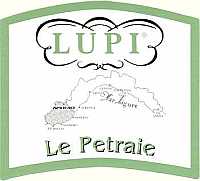
|
|
Riviera Ligure di Ponente Pigato Le Petraie 2003 |
|
| Lupi (Italy) | |
| Grapes: Pigato | |
| Price: € 12,00 | Score: |
| This wine shows a brilliant greenish yellow color and nuances of greenish yellow, very transparent. The nose reveals intense, clean and pleasing aromas which start with hints of apple and hawthorn followed by aromas of peach, broom, pear and plum. In the mouth has good correspondence to the nose, a crisp attack and however balanced by alcohol, good body, intense flavors. The finish is persistent with flavors of apple and plum. | |
| Food Match: Fried fish, Sauteed fish, Pasta and risotto with fish and crustaceans | |
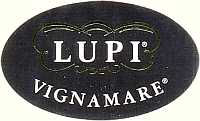
|
|
Vignamare 2000 |
|
| Lupi (Italy) | |
| Grapes: Pigato | |
| Price: € 14,50 | Score: |
| The wine shows a brilliant golden yellow color and nuances of straw yellow, very transparent. The nose denotes intense, clean and pleasing aromas which start with hints of toasted wood, banana and plum followed by aromas of pineapple, hawthorn, broom, apple and hints of smoke. In the mouth has good correspondence to the nose, a crisp attack however well balanced by alcohol, good body, intense flavors, agreeable. The finish is persistent with flavors of apple, plum and banana. Part of this wine ages in barrique. | |
| Food Match: Roasted fish, Fish and mushrooms soups, Roasted white meat, Stuffed pasta | |

|
|
Cent'Anni 2001 |
|
| Sartori (Italy) | |
| Grapes: Corvina (40%), Rondinella (35%), Merlot (25%) | |
| Price: € 25,00 | Score: |
| This wine shows an intense ruby red color and nuances of garnet red, little transparency. The nose reveals intense, clean, pleasing and refined aromas which start with hints of black cherry, raspberry and plum followed by aromas of blueberry, blackberry, dried violet, licorice, tobacco, cinnamon and vanilla. In the mouth has good correspondence to the nose, a slightly tannic attack and however balanced by alcohol, full body, intense flavors, good tannins. The finish is persistent with flavors of blackberry, black cherry and plum. This wine ages for 12 months in barrique followed by 6-9 months of aging in cask. | |
| Food Match: Game, Roasted meat, Braised meat, Hard cheese | |
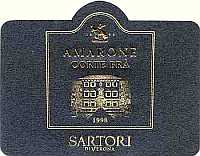
|
|
Amarone della Valpolicella Classico Corte Brà 1998 |
|
| Sartori (Italy) | |
| Grapes: Corvina (50%), Rondinella (40%), Molinara (10%) | |
| Price: € 45,00 | Score: |
| This Amarone shows an intense ruby red color and nuances of garnet red, little transparency. The nose reveals intense, clean, pleasing and refined aromas which start with hints of black cherry and plum followed by aromas of blackberry, dried violet, vanilla, licorice, tobacco, chocolate and hints of menthol. In the mouth has good correspondence to the nose, a slightly tannic attack and however balanced by alcohol, full body, intense flavors, good tannins. The finish is persistent with flavors of blackberry, plum and black cherry. This Amarone ages in cask for 4 years followed by 12 months of aging in barrique and 6 months of aging in bottle. | |
| Food Match: Game, Roasted meat, Braised and stewed meat, Hard cheese | |
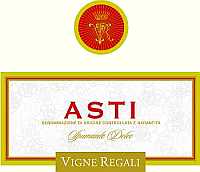
|
|
Asti |
|
| Vigne Regali (Italy) | |
| Grapes: Moscato Bianco | |
| Price: € 6,00 | Score: |
| This Asti shows a brilliant greenish yellow color and nuances of greenish yellow, very transparent, good effervescence, fine and persistent perlage. The nose denotes intense, clean and pleasing aromas which start with hints of grape and peach followed by aromas of broom, banana, litchi and sage. In the mouth has good correspondence to the nose, a sweet, effervescent and crisp attack, however balanced, delicate, intense flavors. The finish is persistent with flavors of grape and peach. | |
| Food Match: Cream desserts, Semifreddo | |
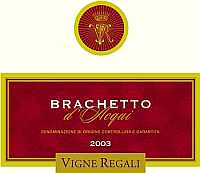
|
|
Brachetto d'Acqui 2003 |
|
| Vigne Regali (Italy) | |
| Grapes: Brachetto | |
| Price: € 8,00 | Score: |
| This wine shows a brilliant ruby red color and nuances of cherry pink, transparent, good effervescence, fine and persistent perlage. The nose reveals clean and pleasing aromas that start with hints of rose and strawberry followed by aromas of raspberry, grape and black cherry. In the mouth has good correspondence to the nose, a sweet, effervescent and crisp attack, however balanced, delicate, intense flavors. The finish is persistent with flavors of grape, strawberry and raspberry. | |
| Food Match: Fruit desserts | |
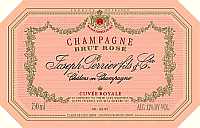
|
|
Champagne Cuvée Royale Brut Rosé |
|
| Joseph Perrier (France) | |
| Grapes: Pinot Noir (75%), Chardonnay (25%) | |
| Price: € 43,00 | Score: |
| This Champagne shows a brilliant salmon pink color and nuances of onion skin pin, transparent, good effervescence, fine and persistent perlage. The nose denotes intense, clean, pleasing and refined aromas which start with hints of raspberry, yeast and tangerine followed by aromas of cherry, banana, strawberry, bread crust and rose. In the mouth has good correspondence to the nose, a crisp and effervescent attack, however balanced, good body, intense flavors, agreeable. The finish is persistent with flavors of tangerine, cherry and raspberry. This Champagne ages in bottle on its lees for 3 years. | |
| Food Match: Pasta and risotto with fish, Broiled fish, Stewed fish, Roasted white meat | |
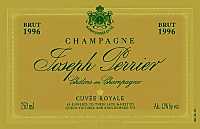
|
|
Champagne Cuvée Royale Millesime 1996 |
|
| Joseph Perrier (France) | |
| Grapes: Pinot Noir (45%), Chardonnay (50%), Pinot Meunier (5%) | |
| Price: € 46,00 | Score: |
| This Champagne shows a brilliant golden yellow color and nuances of golden yellow, very transparent, good effervescence, fine and persistent perlage. The nose reveals good personality with intense, clean, pleasing, refined and elegant aromas which start with hints of praline, baked cake and ripe banana followed by aromas of pineapple, honey, hawthorn, yeast, apple, hazelnut, pear and plum. In the mouth has good correspondence to the nose, a crisp and effervescent attack, however well balanced by alcohol, good body, intense flavors, agreeable roundness. The finish is persistent with flavors of ripe banana, grapefruit and honey. A well made Champagne aged in bottle on its lees for at least 5 years. | |
| Food Match: Roasted fish, White roasted meat, Stewed fish, Broiled crustaceans | |
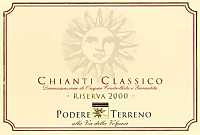
|
|
Chianti Classico Riserva 2000 |
|
| Podere Terreno (Italy) | |
| Grapes: Sangiovese (90%), Canaiolo Nero (10%) | |
| Price: € 16,00 | Score: |
| This Chianti shows an intense ruby red color and nuances of garnet red, moderate transparency. The nose reveals intense, clean and pleasing aromas which start with hints of plum jam and dried violet followed by aromas of black cherry jam, licorice, carob, vanilla, blackberry and hints of menthol. In the mouth has good correspondence to the nose, a slightly tannic attack and however balanced by alcohol, good body, intense flavors, good tannins. The finish is persistent with flavors of plum jam and black cherry jam. This Chianti ages for about 24 months in cask followed by about 6 months in bottle. | |
| Food Match: Roasted meat, Braised and stewed meat, Hard cheese | |
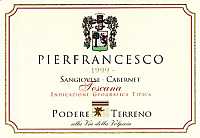
|
|
Pierfrancesco 1999 |
|
| Podere Terreno (Italy) | |
| Grapes: Sangiovese Grosso (90%), Cabernet Sauvignon (10%) | |
| Price: € 17,50 | Score: |
| The wine shows an intense ruby red color and nuances of garnet red, little transparency. The nose reveals intense, clean and pleasing aromas which start with hints of plum, toasted wood and black cherry followed by aromas of blueberry, violet, licorice and eucalyptus. In the mouth has good correspondence to the nose, a slightly tannic attack and however balanced by alcohol, good body, intense flavors, good tannins. The finish is persistent with flavors of plum and black cherry. This wine ages for 12-16 months in barrique followed by about 6 months of aging in bottle. | |
| Food Match: Roasted meat, Braised and stewed meat, Hard cheese | |
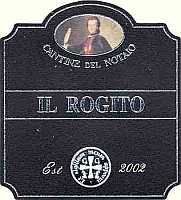
|
|
Il Rogito 2002 |
|
| Cantine del Notaio (Italy) | |
| Grapes: Aglianico | |
| Price: € 14,25 | Score: |
| The wine shows a pale ruby red color and nuances of cherry pink, moderate transparency. The nose denotes intense, clean, pleasing and refined aromas which start with hints of black cherry and raspberry followed by aromas of cyclamen, strawberry, blackberry and hints of vanilla. In the mouth has good correspondence to the nose, a crisp and little tannic attack, however well balanced by alcohol, good body, intense flavors, agreeable. The finish is persistent with flavors of raspberry, strawberry and black cherry. This wine ages for 12 months in cask. | |
| Food Match: Stuffed pasta, Sauteed meat, Roasted fish, Fish soups, Roasted white meat | |
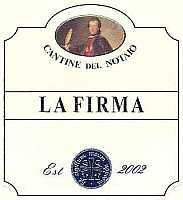
|
|
Aglianico del Vulture La Firma 2002 |
|
| Cantine del Notaio (Italy) | |
| Grapes: Aglianico | |
| Price: € 35,00 | Score: |
| The wine shows an intense ruby red color and nuances of garnet red, little transparency. The nose reveals intense, clean, pleasing, refined and elegant aromas which start with hints of plum and dried violet followed by aromas of black cherry, blueberry, blackberry, vanilla, tobacco, licorice, carob, coriander, eucalyptus and black pepper. In the mouth has good correspondence to the nose, a tannic attack and however well balanced by alcohol, full body, intense flavors, good tannins. The finish is persistent with flavors of plum, blackberry and black cherry. A well made wine. This Aglianico ages in cask for 12 months followed by 4 months of aging in bottle. | |
| Food Match: Braised and stewed meat, Roasted meat, Game, Hard cheese | |
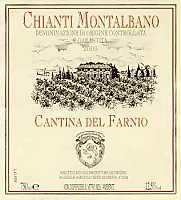
|
|
Chianti Montalbano Cantina del Farnio 2003 |
|
| Betti (Italy) | |
| Grapes: Sangiovese (90%), Cabernet Sauvignon, Canaiolo Nero, Trebbiano Toscano (10%) | |
| Price: € 6,30 | Score: |
| The wine shows a brilliant ruby red color and nuances of ruby red, moderate transparency. The nose denotes intense, clean and pleasing aromas which start with hints of black cherry, raspberry and violet followed by aromas of plum, blueberry and cyclamen. In the mouth has good correspondence to the nose, a slightly tannic and crisp attack however balanced, good body, intense flavors. The finish is persistent with flavors of raspberry and black cherry. This Chianti ages for 6 months in cask and for 2 months in bottle. | |
| Food Match: Broiled meat and barbecue, Stewed meat, Hard cheese | |

|
|
Sangiovese di Romagna Riserva Laurento 2000 |
|
| Umberto Cesari (Italy) | |
| Grapes: Sangiovese Grosso (90%), Cabernet Sauvignon (10%) | |
| Price: € 23,50 | Score: |
| This wine shows an intense ruby red color and nuances of garnet red, moderate transparency. The nose denotes intense, clean, pleasing and refined aromas which start with hints of plum and dried violet followed by aromas of black cherry, blueberry, cyclamen, licorice, carob and vanilla. In the mouth has good correspondence to the nose, a slightly tannic attack and however well balanced by alcohol, good body, intense flavors, good tannins. The finish is persistent with flavors of plum and black cherry. | |
| Food Match: Roasted meat, Broiled meat and barbecue, Braised and stewed meat, Hard cheese | |

|
|
Rosso del Monte 2003 |
|
| Accattoli (Italy) | |
| Grapes: Cabernet Sauvignon (34%), Montepulciano (33%), Pinot Noir (33%) | |
| Price: € 5,76 | Score: |
| This wine shows an intense ruby red color and nuances of ruby red, moderate transparency. The nose reveals intense, clean and pleasing aromas which start with hints of black cherry and plum followed by aromas of blueberry, blackberry and violet. In the mouth has good correspondence to the nose, a slightly tannic attack and however balanced, good body, intense flavors. The finish is persistent with flavors of black cherry and blackberry. This wine ages for 3 months in steel tanks and for 4 months in bottle. | |
| Food Match: Broiled meat, Stewed meat, Roasted meat | |
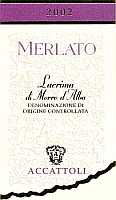
|
|
Lacrima di Morro d'Alba Merlato 2003 |
|
| Accattoli (Italy) | |
| Grapes: Lacrima di Morro d'Alba | |
| Price: € 8,92 | Score: |
| The wine shows a brilliant ruby red color and nuances of purple red, moderate transparency. The nose denotes intense, clean and pleasing aromas which start with hints of cherry and raspberry followed by aromas of blackberry, rose and cyclamen. In the mouth has good correspondence to the nose, a slightly tannic attack and pleasing crispness, however balanced, good body, intense flavors. The finish is persistent with flavors of cherry and raspberry. This wine ages i steel tanks for 5 months. | |
| Food Match: Pasta with meat, Sauteed meat, Roasted white meat | |
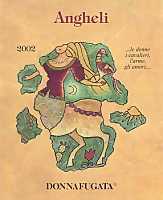
|
|
Angheli 2002 |
|
| Donnafugata (Italy) | |
| Grapes: Nero d'Avola (50%), Merlot (50%) | |
| Price: € 14,20 | Score: |
| This wine shows an intense ruby red color and nuances of garnet red, little transparency. The nose reveals intense, clean, pleasing, refined and elegant aromas that start with hints of plum, black cherry and dried violet followed by aromas of blueberry, blackberry, vanilla, licorice, tobacco, cocoa, mace and menthol. In the mouth has good correspondence to the nose, a slightly tannic attack and however balanced by alcohol, good body, intense flavors, good tannins. The finish is persistent with flavors of blackberry, plum and black cherry. A well made wine. Angheli ages for 12 months in barrique followed by at least 4 months of aging in bottle. | |
| Food Match: Stewed and braised meat with mushrooms, Roasted meat, Hard cheese | |
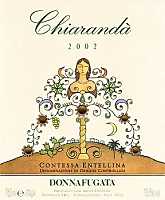
|
|
Contessa Entellina Chiarandà 2002 |
|
| Donnafugata (Italy) | |
| Grapes: Chardonnay (50%), Ansonica (50%) | |
| Price: € 20,20 | Score: |
| This wine shows a pale golden yellow color and nuances of straw yellow, very transparent. The nose reveals intense, clean and pleasing aromas which start with hints of plum and vanilla followed by aromas of banana, hawthorn, toffee, orange, almond, quince jam, apple, honey and ripe peach. In the mouth has good correspondence to the nose, a crisp attack and however well balanced by alcohol, good body, intense flavors, agreeable. The finish is persistent with flavors of apple, plum and almond. A well made wine. Chiarandà ages for 6 months in barrique followed by at least 6 months of aging in bottle. | |
| Food Match: Roasted fish, Stuffed pasta with mushrooms, Roasted white meat, Stewed fish | |
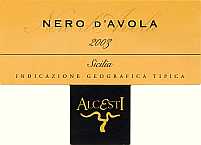
|
|
Nero d'Avola 2003 |
|
| Alcesti (Italy) | |
| Grapes: Nero d'Avola | |
| Price: € 10,00 | Score: |
| This wine shows a brilliant ruby red color and nuances of ruby red, moderate transparency. The nose reveals intense, clean and pleasing aromas which start with hints of plum and blackberry followed by aromas of black cherry, blueberry, violet, carob and licorice. In the mouth has good correspondence to the nose, a slightly tannic attack and however balanced by alcohol, good body, intense flavors. The finish is persistent with flavors of plum and black cherry. This Nero d'Avola ages in barrique for 6 months. | |
| Food Match: Roasted meat, Stewed meat, Hard cheese | |
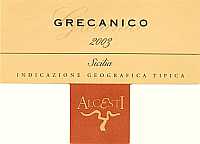
|
|
Grecanico 2003 |
|
| Alcesti (Italy) | |
| Grapes: Grecanico | |
| Price: € 8,00 | Score: |
| This wine shows a pale straw yellow color and nuances of greenish yellow, very transparent. The nose reveals intense, clean and pleasing aromas which start with hints of pear and hawthorn followed by aromas of peach, apple, broom and plum. In the mouth has good correspondence to the nose, a crisp attack and however balanced by alcohol, good body, intense flavors. The finish is persistent with flavors of apple, pear and plum. This wine ages for 6 months in steel tanks. | |
| Food Match: Fried fish, Sauteed fish, Pasta and risotto with fish | |
Fattoria dei BarbiBetween tradition and innovation, in Montalcino, heart of Brunello, Fattoria dei Barbi joins more than 200 years of history to the most advanced wine making technologies |
|
One of the most famous sons of Montalcino - the enchanting Tuscan town in the province of Siena - certainly is Brunello, not only the name with which is locally called Sangiovese Grosso grape, but also - and first of all - a wine, one of the most renowned and looked for wines of Italy. Brunello di Montalcino is also that wine which contributed during the past century to the success of Italian enology in the world and to the affirmation of its quality: a success that continues still today despite its more than one hundred years of history. Among the historical wineries which contributed to the success and the affirmation of Brunello di Montalcino there is Fattoria dei Barbi, a prestigious name of Tuscan enology which sets its ancient roots in 1790 and established by Colombini family, which already owned estates in Montalcino since 1352.
In 1790 Colombini family acquired the now famous Fattoria dei Barbi and since those times they scrupulously committed to viticulture and wine making. In 1840 a Fattoria dei Barbi's Brunello di Montalcino is awarded at an exposition in Bordeaux: it will be the first of a long series of awards conferred both in Italy and abroad. The commitment and efforts of Fattoria dei Barbi in the viticulture and wine is witnessed by an exclusive collection of bottles of Vinsanto and Brunello di Montalcino of which the most ancient exemplars are dated back to 1870 until nowadays. Fattoria dei Barbi has also achieved some interesting records, including the first sale of wine by mail (1936) and, in 1962, the first export of Brunello di Montalcino in Europe and America, the production, in 1974, of the first grappa of Brunello. After more than 210 years of history, Fattoria dei Barbi is still today one of the most known and appreciated producers of Brunello di Montalcino, as well as other wines such as Rosso di Montalcino, Chianti, Morellino di Scansano, Vinsanto and some IGTs such as Brusco dei Barbi and Birbone Toscano. Fattoria dei Barbi also produces olive oil, cheese and cured meat, it owns an agritouristic business and the restaurant “La Taverna dei Barbi” where can be tasted and appreciated the typical cooking of Tuscany and its wines. Today Fattoria dei Barbi occupies an area of 370 hectares (914 acres), of which more than 90 (222 acres) used for the cultivation of the vine and the rest used for olive trees, woods and fields. The average density of vineyards is of more than 4500 plants per hectare. Most of the estate is located in the commune of Montalcino, whereas in Scansano the property occupies an area of 50 hectares (123 acres). Fattoria dei Barbi owns two wineries, one at Montalcino and the other at Scansano, in which are found more than 200 casks, 200 barriques and 120 steel and concrete tanks, with a total capacity of 20,000 hectoliters (about 528,000 gallons). The yearly production of Fattoria dei Barbi is of about 800,000 bottles, of which one third is Brunello di Montalcino.
Today Fattoria dei Barbi is run by Stefano Cinelli Colombini, descendant of the ancient family from Siena and owners since 1790, whose interest for technological innovation has allowed the ancient winery to achieve further progresses. Since he started working for Fattoria dei Barbi in 1981, Stefano Cinelli Colombini has increased the acreage destined to vineyards from 22 hectares (54 acres) to the current 110 (271 acres). In order to accomplish the goal of improving the quality while respecting tradition, he conducted researches in Montalcino's vineyards and in the most advanced techniques. The results obtained in more than twenty years of research on the density of vineyards and on viticulture - besides 200 years of researches done by the family - are available at Fattoria dei Barbi. The interest of Stefano Cinelli Colombini for technology allowed him to create - with the collaboration of University of Siena and Madrid - the first electronic nose for wine analysis, as well as an innovative biosensors system for grape analysis in collaboration with University of Pisa and Tor Vergata (Rome). In the spirit of joining technology and tradition, Stefano Cinelli Colombini is studying in collaboration with the University of Pisa, a system that can recreate the optimal conditions for harvesting, the one typical at the end of October with grapes and cellars colder than the current average conditions. The result is represented by the PMF project (Pre-Macerazione a Freddo, Cold Pre-Maceration) in 2001, with which it is possible to obtain a Brunello with more polyphenols, tannins and anthocyanins, even twice the normal quantities, while allowing at the same time to keep the typical characteristics, flavors and aromas of Sangiovese di Montalcino. This system allows the enrichment of Brunello without alteration. Stefano Cinelli Colombini's passion for this famous wine has led him to establish the Museo della Comunità di Montalcino e del Brunello (Museum of Montalcino's community and Brunello), a non profit foundation which occupies an area of 1,000 square meters (1,195 square yards) and having the goal of spreading the history of Brunello and the culture which created it. The work of Stefano Cinelli Colombini is also tangible in the commercial aspects of the winery. During his 25 years of work, Fattoria dei Barbi has increased its market quotes by increasing the production from 220,000 bottles in 1981 to the current 800,000 and a total income of ten millions and a half of euros. Fattoria dei Barbi's wines are currently exported in many countries of the world, including United States of America, United Kingdom and Canada. In 1997 was acquired Fattoria del Vivaio at Scansano and today it occupies an area of 104 hectares (256 acres) of which thirty destined to vineyards, a cellar and a wonderful villa facing towards the Argentario. The current production of Fattoria dei Barbi is thus divided: about 220,000 bottles of Brunello, 100,000 of Rosso di Montalcino, 60,000 of Morellino di Scansano and the rest of Chianti and Tuscan IGTs. Fattoria dei Barbi has always believed in low yields per plants: the average density of vines is 5,200 per hectare allowing a production of less than 1.5 kilograms (3.3 pounds) per vine, equal to one bottle and a half per plant. Qualitative selection is very scrupulous: less than 60% of Fattoria dei Barbi's potential production is bottled as Brunello di Montalcino whereas the rest is declassed as Rosso di Montalcino.
|
||||||||||||||||||||
|
Score legend Prices are to be considered as indicative. Prices may vary according to the country or the shop where wines are bought |
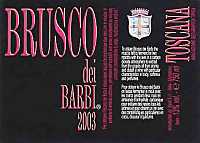
|
|
Brusco dei Barbi 2003 |
|
| Fattoria dei Barbi (Italy) | |
| Grapes: Sangiovese | |
| Price: € 4,90 | Score: |
| This wine shows an intense ruby red color and nuances of ruby red, little transparency. The nose reveals intense, clean and pleasing aromas which start with hints of black cherry and plum followed by aromas of cyclamen, raspberry, violet and blueberry. In the mouth has good correspondence to the nose, a slightly tannic attack and pleasing crispness, however balanced by alcohol, good body, intense flavors, good tannins. The finish is persistent with flavors of plum and black cherry. Brusco dei Barbi ages in steel tanks. | |
| Food Match: Stuffed pasta, Cold cuts, Broiled meat and barbecue, Sauteed meat | |
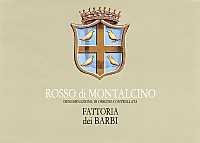
|
|
Rosso di Montalcino 2002 |
|
| Fattoria dei Barbi (Italy) | |
| Grapes: Sangiovese | |
| Price: € 9,00 | Score: |
| The wine shows a brilliant ruby red color and nuances of ruby red, moderate transparency. The nose denotes intense, clean, pleasing and refined aromas which start with hints of black cherry, plum and violet followed by aromas of cyclamen, blackberry, licorice, carob, vanilla and hints of hay. In the mouth has good correspondence to the nose, a slightly tannic attack and however balanced by alcohol, good body, intense flavors, good tannins. The finish is persistent with flavors of black cherry, plum and blackberry. | |
| Food Match: Broiled meat and barbecue, Roasted meat, Stewed meat | |
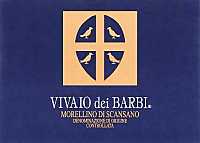
|
|
Morellino di Scansano Vivaio dei Barbi 2001 |
|
| Fattoria dei Barbi (Italy) | |
| Grapes: Sangiovese | |
| Price: € 8,70 | Score: |
| The wine shows a brilliant ruby red color and nuances of garnet red, moderate transparency. The nose reveals intense, clean, pleasing and refined aromas which start with hints of cherry and raspberry followed by aromas of blueberry, cyclamen, plum, violet and licorice. In the mouth has good correspondence to the nose, a slightly tannic attack and however balanced by alcohol, good body, intense flavors, good tannins, agreeable. The finish is persistent with flavors of black cherry, plum and blueberry. This wine ages for 9 months in cask followed by more than 4 months of aging in bottle. | |
| Food Match: Roasted meat, Broiled meat and barbecue, Stewed meat, Hard cheese | |
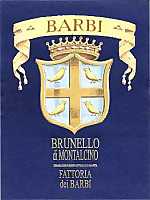
|
|
Brunello di Montalcino 1999 |
|
| Fattoria dei Barbi (Italy) | |
| Grapes: Sangiovese | |
| Price: € 21,00 | Score: |
| This Brunello shows a brilliant ruby red color and nuances of garnet red, little transparency. The nose reveals intense, clean, pleasing, refined and elegant aromas which start with hints of black cherry and dried violet followed by aromas of raspberry, blueberry, plum, vanilla, tobacco, licorice, carob, cinnamon and mace. In the mouth has good correspondence to the nose, a slightly tannic attack and however balanced by alcohol, full body, intense flavors, good tannins. The finish is persistent with flavors of plum and black cherry. A well made wine. This Brunello di Montalcino ages for 2 years in cask followed by more than 4 months of aging in bottle. | |
| Food Match: Braised and stewed meat, Roasted meat, Game, Hard cheese | |
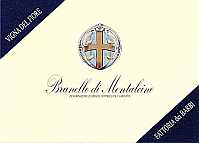
|
|
Brunello di Montalcino Vigna del Fiore 1998 |
|
| Fattoria dei Barbi (Italy) | |
| Grapes: Sangiovese | |
| Price: € 34,00 | Score: |
| This Brunello shows a brilliant ruby red color and nuances of garnet red, little transparency. The nose reveals good personality with intense, clean, pleasing, refined and elegant aromas which start with hints of plum jam and black cherry jam followed by aromas of blueberry jam, dried violet, vanilla, chocolate, licorice, tobacco, thyme and camphor. In the mouth has good correspondence to the nose, a slightly tannic attack and however balanced by alcohol, full body, intense flavors, good tannins, agreeable. The finish is persistent with flavors of plum jam and black cherry jam. A well made wine. This Brunello di Montalcino ages for 2 years in cask followed by more than 4 months of aging in bottle. | |
| Food Match: Braised and stewed meat, Roasted meat, Game, Hard cheese | |
| Fattoria dei Barbi - Località Podernuovi - 53024 Montalcino, Siena (Italy) - Tel. +39 577 841111 Fax. +39 577 841112 - Winemaker: Paolo Salvi - Established: 1790 - Production: 800.000 bottles - E-Mail: info@fattoriadeibarbi.it - WEB: www.fattoriadeibarbi.it |
Cellar Journal |
|
This section is reserved to wine producers who want to publish news and information about their business, to announce new products or just for communicating to its customers information and promotions about their products and activity. Send news to be published at our e-mail address.
|
News |
|
In this section will be published news and information about events concerning the world of wine and food. Whoever is interested in publishing this kind of information can send us a mail at our address.
|
Production of Fortified WinesLeading figures in the trades of the past, in that period in which they were particularly looked for, fortified wines are an explosion of aromas and flavors, result of a wise production technique |
|
If we consider the current consumption of fortified wines - very scarce and not very common as opposed to other styles - it seems impossible to believe these wines have been so important and so famous in the past and capable of determining the trades of those times. Whereas in the past names like Jerez, Port, Marsala and Madeira - just to mention the most famous representatives of this category - were considered great wines destined to noble classes, today they are practically ignored and scarcely appreciated saved by a small group of wine lovers. It should be remembered the decay of these wines was also because of the negligence and mistakes of many producers therefore damaging their image and credibility. After the incredible period of decay which lasted until the 1980's, in the last twenty years producers are finally revaluating the quality of these wonderful wines also by means of appropriate commercial strategies: the first tangible result is that many wine lovers are getting more and more interested in fortified wines for the first time. Whether this is the rebirth of a “myth”, like it was in the past, it is pretty hard to tell, as well as scarcely probable because of the impressive improvement of the quality of wines in general. However it is encouraging to see these glorious wines are getting back their credibility and their fame also thanks to the work of producers who are currently producing fortified wines of very high quality. It should also be considered fortified wines are not easy to understand and to appreciate: they takes a higher attention and a trained sensorial skill in order to perceive their extremely complex aromas and flavors, like in no other wine. The high quality of fortified wines of the last twenty years certainly encourages the wine lover to discover this new world by allowing him or her to live a new sensorial experience. Moreover, if we consider the fact these wines have a remarkable longevity which allows them to develop very complex aromas and flavors, fortified wines are not wines to be tasted absentmindedly: they have to be tasted in tranquility and in little sips, while contemplating their complex aromatic and gustatory evolution which is revealed only to those who have the patience to listen to them.
|
|
Before discussing the aspects about production, let's try to understand what is a fortified wine. This style of wines - that in Italy can also be called liquoroso - is differentiated by all other styles for the fact some alcohol is added during production. The purpose of this process - called fortification - is not only the increasing of alcohol volume, as it may apparently be seen. Indeed, it is a delicate process in which the quality of the fortifying agent - usually ethyl alcohol or brandy - plays a fundamental role on the quality of the finished product as well. The best fortified wines are the ones in which the ethereal impact of the fortifying agent does not influence the primary organoleptic qualities of wine. In other words, in a quality fortified wine the ethereal aroma of alcohol should be scarcely perceivable, even better imperceptible, while avoiding to cover the main and typical aromas of wine.
If the aroma of alcohol should not be perceived in these wines and the increasing of the alcohol percentage is not the main purpose of fortification, why does alcohol is added to wine? In order to answer to this question it is necessary to remember that not all fortified wines have high percentages of alcohol: in many cases it is not higher than 14%, however there are wines whose percentage in alcohol can be as high as 20%. The first advantage of fortification is to ensure a better preservability of wine, therefore ensuring a better longevity while reducing risks of degradation. This advantage was well known to wine merchants of the past, who usually used this “trick” in order to allow wine to stand to the not favorable conditions in ship's hold until destination. Famous is the history of Marsala - the great Sicilian fortified wine - which owes its success to the intuition of John Woodhouse who added some brandy in the casks before being shipped to England. The second reason for which fortification is used is connected to sweetness. In the production of sweet wines fortification is done during alcoholic fermentation in order to stop the action of yeast - which usually does not stand to percentages higher than 16.4% - therefore keeping a certain quantity of sugar that will give sweetness to wine. Fortification done in the aim of keeping sweetness is also used - for example - in French Vin Doux Naturel, in some styles of Port and in sweet Madeiras. Moreover fortification ensures a better microbiological stability and prevents any other fermentation after the production. However, stopping fermentation is not the only way allowing the production of fortified sweet wines. In some wines it is also added a mixture of non fermented or partially fermented grape juice and alcohol - called mistella - whose purpose is both to increase alcohol percentage and wine's sweetness.
|
||||||||
|
An important role in the production of fortified wines is played by alcohol, whose quality and production method both largely influence the organoleptic qualities of wine. The alcohol used for fortification is produced with different methods and substances - however and always according to the production disciplinary of each wine - and it can be obtained by the distillation of grape's pomace, wine, sugar beet, sugar cane, agricultural byproducts and even petrol. In some cases are also used wine brandies aged in cask, such as Cognac. The organoleptic qualities of the alcohol used for fortification represent - as a matter of fact - an important factor because, it should be remembered, in quality fortified wines the perception of ethereal characteristics should be the least perceptible possible. Of course quality alcohol has a higher cost - and this also affects the cost of the finished product - and it is used in quality fortified wines destined to a long period of aging in bottle. In fortified wines intended for early consumption, the quality of alcohol is generally lower. The alcohol mainly used in fortified wines is produced with the continuous distillation method, the same system used, for example, for the production of many brandies. The most neutral alcohols, poor in aromatic substances, are generally used for the fortification of wines destined to an early consumption or in those wines which have to keep their primary aromatic characteristic, such as fortified wines produced with Muscat Blanc grapes. The alcohol produced with the method of discontinuous distillation - the same system used for the production of grappa - is rarely used in the fortification of wines because of its high quantity of aromatic substances which would greatly influence the aromas of wine. It should be remembered alcohol or the fortifying agent, have their own aromas and alter - or better to say, enrich - the aromatic qualities of the base wine. The aromatic qualities of alcohol should not be confused with its ethereal aroma, that is the characteristic pungent and burning smell, that when it is evidently perceivable in a fortified wine it is considered as a fault. The preparation of base wine depends on the style of wine to be obtained. The production process begins just like any other wine: it begins with harvest, the grapes are crushed in order to obtain the must that will be subsequently fermented. In certain wines - such as some styles of Port, sweet Madeiras and French Vin Doux Naturel, the fermentation of must is stopped by adding alcohol in order to inhibit the activity of yeast while keeping residual sugar that will contribute to wine's sweetness. In the so called vin de liqueur, such as Pineau de Charentes produced in the Cognac region and usually served as a sweet aperitif, the fermentation of must is completely avoided. Soon after the grape has been pressed, a certain quantity of Cognac aged in cask is being added to the must and the alcohol will prevent any fermentative process. The result is a fortified grape juice which will be aged in cask for some months as well as for some years. In dry fortified wines - such as Jerez Fino and Manzanilla or Marsala Vergine - alcohol, or the fortifying agent, is added at the end of the production of base wine. In this case the production is just like any other dry wine - white or red - with an alcoholic percentage of about 12%, and after the usual practices of stabilization and aging are done, just like any other wine, some alcohol is added until reaching a percentage between 15% and 22%. This operation is just the beginning of a new production phase, because it will be the subsequent practices that will give character, complexity and typicality to the final product. These processes have a variable duration from 12 months to some tens of years, such as in case of some styles of Port, Marsala, Madeira and Jerez.
Apparently, the systems used for the production of many fortified wines would make anyone think about a deliberate degradation and spoilage of the wine in order to turn it into something undrinkable. In fact many of the organoleptic qualities of fortified wines - the qualities that make fortified wines complex and amazing - are the result of violent alterations that would be lethal for any other wine and thanks to the presence of alcohol, and its capacity of preservative, the wine can be transformed into a sublime nectar. Oxidation, broad thermal variations, heating, veil and partially filled casks, are all phenomena considered negative in any wine and are always and scrupulously avoided, as they are cause of chemical and organoleptic alterations that would make the wine undrinkable or however not agreeable. In fortified wines these phenomena are essential and are deliberately encouraged. In case these very phenomena are encouraged in normal wines, the result would be catastrophic because they would be cause of other faults and defects, including the development of vinegar bacteria during the phase of oxidation. The evolution of fortified wines is generally done in wood casks usually filled for four fifths of total volume and in order to expose the wine to the effects of oxygen, in other words it is being encouraged an oxidation, even strong, that will give wine particular organoleptic qualities. In other areas of the world - of which the most famous one is Jerez - in the surface of contact with air is usually formed the so called flor, also known as veil, a particular variety of yeast of the Saccharomyces family that, besides releasing its organoleptic qualities to wine, it also shields it from the excessive effects of oxidation. Another method used for the aging of fortified wines is the so called solera y criaderas - particularly known for the production of Jerez and used for other wines as well, such as Marsala - consists in ensuring a constant quality of the product over the time. The aging and the evolution of fortified wines can last many years - frequently tens of years - and in this period complex and extraordinary aromatic qualities are being developed, qualities which make this style of wines unique. At the end of the aging period, the wine is drawn off from casks and processed with the usual stabilization and clarification practices, then it is bottled and ready for commercialization. The production of fortified wines is among the most complex and delicate enological techniques, a patient work which lasts years and that allows the production of an absolutely unique wine, capable of satisfying every wine lover who is looking for particular and rich emotions and who is not easy to be seduced by the craze of modern lifestyles.
|
||||||||||||
ChestnutTypical fruits of autumn, companion of cold nights together with friends and a good glass of wine, chestnut is also an ingredient of cooking and pastry |
|
|
|
The chestnut “castanea sativa Miller”, belongs to the beech family, is a tree with caducous leaves and its height can also reach thirty meters (98 feet). It has a large trunk and a rounded foliage, the bark is smooth and shows small white spots. The leaves, that can be long 20 centimeters (7.8 inches), have a short stem and a narrow lanceolate shape, the border of the leaf is serrate, the young leaves are hairy whereas adult leaves are smooth and shiny. Flowers are separated: male flowers are contained in glomerules inserted in a spike at the base of the leaves, the female flowers are enclosed in an involucre - called dome - made of many bracts. The fruit is composed by one to three achenes, called chestnuts, enclosed in a brown colored and shiny pericarp which is hairy in the inside. The part known with the name of chestnut husk, is the dome of the female flower which grew up with the fruit and, when it has reached full ripeness, it opens up in four parts covered by many prickles.
The chestnut is a very ancient plant and it was present since prehistory (since the Cenozoic era), it is very longeval and in England is famous a tree called “the big tree of Tortworth” which according to a legend it is believed to be more ancient than their King John; another plant in the Greenwich park is considered millenary. It grows on a very large area of the planet, in Europe, in some parts of Asia, Greece, Turkey, Algeria, in the Balkan peninsula and in America. Chestnut is a very longeval tree but its growth is very slow, it does not like limestone and prefers deep and well drained soils, it begins to bear fruits at around 25 years of age and reach its apex at around 50. Chestnuts are typical fruits of autumn, they spontaneously fall from the tree from September to December, and it is right in this period they are being harvested. Chestnuts are mentioned by Virgil both in the second book of the Georgics, where he suggests to graft chestnut with a beech, as well as in the Eclogues where he mentions chestnuts cooked with milk and consumed with cheese. In the 1700's in the tables of the noble classes appeared the firsts “marrons glacée” and in the same period in Paris the pharmacist Bonneau invents a chocolate made of 50% of cocoa and 50% of toasted dried chestnut flour. Chestnut is a fruit currently looked for during autumn, because it is suited for the preparation of salty recipes and sweet recipes, it is a wholly genuine and natural food, it does not require any chemical treatment or phytotherapy, it is a product that meets the canons of organic culture. Today when referring to chestnuts, they are classified into chestnuts and marrons chestnuts, even though the distinction is not always clear. Chestnuts are the fruit of the wild tree, having a pretty variable shape, size and flavor even in case they were produced by the same tree; marrons chestnuts are the fruit of selection and grafting which gave origin to a superior quality plant and have standard characteristics. Chestnuts, since ever, have represented a precious help in the nutrition of poor people. They were once known with the name of “bread of tree”, they have been a precious resource for survival. When traditional grains were not enough for the nutrition of all the family members, chestnuts were used instead, boiled, roasted or in form of flour. The chestnut is a patient tree with little demands, it took little of time as well as little efforts to the farmers while giving a fruit that, thanks to its characteristics and nutritional qualities, has allowed people to survive during hard times. Chestnuts are also used to feed animals.
|
||||||||
|
Chestnuts are an atypical fruit, they are rich in complex carbohydrates, just like grains. Chestnuts contain fibers, a high quantity of mineral salts, in particular potassium, phosphor, sulfur, magnesium, chlorine, calcium, iron and sodium; as well as vitamins B1 and B2 and a remarkable quantity of vitamin C (almost as much as lemons), 4% of aminoacids, 40% of starch (glucose). The cooking process transforms part of the starch into simple sugars, therefore giving the characteristic sweetness. One hundred grams of fresh chestnuts contains about 200 Kcal, whereas dried chestnuts provide 370. In dried chestnuts is absent vitamin C, which is lost during the drying process. Chestnuts, because of their high content in proteins, vitamins, mineral salts, lipid and carbohydrates, are a very nutritive food, they are tonics for muscles and veins, antinfective, reconstituent and antianemic. Chestnuts are good for elder people, kids and convalescents, are a good remedy for varices and hemorrhoids, prevent the aging of the skin and, last but not the least, they are easily digestible. Chestnut flour is used in many recipes as a substitute for wheat flour for people suffering from grains intolerance. One hundred grams of chestnuts contains about 200 Kcal (of which 7% from proteins, 84% from carbohydrates and 9% from lipids), 0.08 mg Vitamin B1 (Tiamin), 0.28mg Vitamin B2 (Riboflavin), 1.11mg Vitamin B3 (Niacin), 43,00mg Vitamin C.
|
||||
|
Few rules for the harvesting for personal consumption. First of all avoid fenced chestnut woods or private properties, in such cases it is good to ask for permission. Have the highest respect for wood. Take a stick to be used for the removal of leaves and to open chestnut husks. It is not advisable to use plastic bags for harvesting chestnuts; it is preferable to use a wicker basket in order to allow fruits to breathe. Do not destroy or harvest bad or rotten chestnuts because they are indispensable for the balance of wood. Discard soft, powdery or opaque looking chestnuts because it is more likely they are not edible anymore.
|
|
Because of the high demand, chestnuts have become a pretty important source of commercial profits, therefore they undergo some phases of processing which allow to prolong preservation times and to broaden the market area, both in space and in time. After harvesting, fresh chestnuts are divided according to their size. This first phase will determine the destination of the fruits: some will be destined to sale, the others will undergo other processing phases. Thanks to the immersion in water it is possible to determine good chestnuts from bad ones or potentially bad ones, as bad chestnuts are lighter and tend to float. The next phase consists in a thermal treatment which greatly reduce bacteria of the fruit, then follows brushing and polishing. At the end chestnuts are being packed, kept in refrigerators and therefore ready for commercialization. Discarded chestnuts not considered good for commercialization, are not eliminated and, by means of specific machineries, they are peeled, dried, packed and then commercialized. The residual part of the processing, that is broken fruits, are ground and used for the production of chestnut flour.
|
|
Chestnut harvested and destined for personal consumption should be dried by spreading them in a wooden surface, they must not be kept for a long time because they easily tend to wither. Some keep the fruits, incised, in the refrigerator. Tradition teaches that for a good keeping of chestnuts, it is advisable to follow the practice of novena. The system consists in plunging the chestnuts in a bucket filled with water at room temperature. During the first day the chestnuts will be stirred in order to have the bad exemplars to float and without changing the water. This practice allows water to encourage a slight formation of lactic fermentation that will acidify the content. After nine days rinse and dry the chestnuts on a wooden surface while paying attention to avoid any contact with metallic materials. At the end of novena, keep chestnuts in a cool place and in jute bags, for a period of 2 or 3 weeks, or freeze them in a refrigerator while remembering, in this specific case, to cut the peel. Before purchasing chestnuts, it is good to remember the fruits must be hard, the peel - when pressed with fingers - must not sink. The price of chestnuts usually depends on their size, however a bigger chestnut is not sweeter or better than a small one. Generally speaking, chestnuts of average or big size are more suited for roasting, whereas small sized chestnuts are more suited for boiling. Roast chestnuts are less digestible of boiled chestnuts because of the lesser homogeneity of cooking.
|
AquavitaeReview of Grappa, Distillates and Brandy |
|
|
| Distillates are rated according to DiWineTaste's evaluation method. Please see score legend in the "Wines of the Month" section. |

|
|
Grappa di Aglianico del Vulture |
|
| Cantine del Notaio (Italy) | |
| (Distiller: Distilleria G. Bertagnolli) | |
| Raw matter: Pomace of Aglianico | |
| Price: € 25,50 - 500ml | Score: |
| This grappa is colorless, limpid and crystalline. The nose is intense with pleasing aromas of dried plum, blackberry, raspberry, walnut-husk and hazelnut with almost imperceptible alcohol pungency. The taste is intense, good smoothness and balanced sweetness, the alcohol is perceptible although not aggressive and dissolves rapidly, agreeable. The finish is persistent with a pleasing sweet hint and flavors of dried plum and raspberry. A well made grappa produced with discontinuous method in steam operated alembic stills. Alcohol 42%. | |
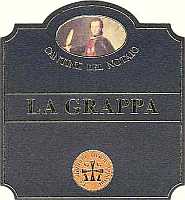
|
|
Grappa di Aglianico del Vulture Affinata |
|
| Cantine del Notaio (Italy) | |
| (Distiller: Distilleria G. Bertagnolli) | |
| Raw matter: Pomace of Aglianico | |
| Price: € 36,00 - 500ml | Score: |
| This grappa shows an intense amber yellow color, limpid and crystalline. The nose reveals intense and clean aromas of vanilla, caramel, hazelnut, dried plum, licorice, honey, dried fig and chocolate with almost imperceptible alcohol pungency. The taste is intense and smooth, good balanced sweetness, perceptible alcohol pungency, not excessively aggressive which dissolves rapidly, agreeable. The finish is persistent and round with pleasing sweet hint and flavors of dried plum, honey, licorice and hazelnut. A well made grappa produced with discontinuous method in steam operated alembic stills and aged in barrique for about 30 months. Alcohol 42%. | |
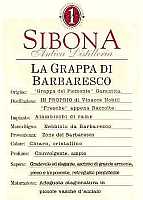
|
|
Grappa di Barbaresco |
|
| Sibona (Italy) | |
| Raw matter: Pomace of Nebbiolo from Barbaresco | |
| Price: € 18,00 - 500ml | Score: |
| This grappa is colorless, limpid and crystalline. The nose denotes intense and clean aromas in which are perceived violet, plum, beeswax, licorice, cherry, strawberry and raspberry with imperceptible alcohol pungency. The taste is intense, good smoothness and balanced sweetness, the alcohol pungency is perceptible however dissolves rapidly, agreeable. The finish is very persistent with pleasing sweet hints and flavors of plum and licorice. A well made grappa produced with discontinuous method in steam operated alembic stills. Alcohol 44%. | |
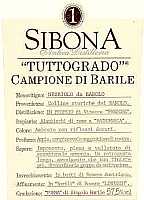
|
|
Grappa di Barolo Tuttogrado Campione di Barile |
|
| Sibona (Italy) | |
| Raw matter: Pomace of Nebbiolo from Barolo | |
| Price: € 24,00 - 500ml | Score: |
| This grappa shows a pale amber yellow color, limpid and transparent. The nose reveals intense and pleasing aromas of vanilla, plum, licorice, raspberry, honey, hazelnut, dried violet and strawberry with perceptible alcohol pungency although not excessively aggressive. The taste is intense with very perceptible alcohol pungency even though it tends to dissolve rapidly, good and balanced sweetness. The finish is persistent with pleasing sweet hints and flavors of honey, hazelnut and raspberry. A well made grappa produced with discontinuous method in steam operated alembic stills and aged in oak casks. Alcohol 57.5%. | |
Wine Parade |
|
|
| The best 15 wines according to DiWineTaste's readers. To express your best three wines send us an E-mail or fill in the form available at our WEB site. |
| Rank | Wine, Producer | |
|---|---|---|
| 1 |
| Montepulciano d'Abruzzo Villa Gemma 1999, Masciarelli (Italy) |
| 2 |
| Turriga 1998, Argiolas (Italy) |
| 3 |
| Amarone della Valpolicella Classico Capitel Monte Olmi 1999, Tedeschi (Italy) |
| 4 |
| Harmonium 2001, Firriato (Italy) |
| 5 |
| Brunello di Montalcino Prime Donne 1998, Donatella Cinelli Colombini (Italy) |
| 6 |
| Riesling Cuvée Frédéric Emile 1999, Maison Trimbach (France) |
| 7 |
| Barolo Cicala 1999, Poderi Aldo Conterno (Italy) |
| 8 |
| Pinot Noir Napa 2002, Clos du Val (USA) |
| 9 |
| Aglianico del Vulture La Firma 2000, Cantine del Notaio (Italy) |
| 10 |
| Chablis Grand Cru Les Clos 2002, Domaine Billaud-Simon (France) |
| 11 |
| Jerez Fino Tio Pepe, Gonzalez Byass (Spain) |
| 12 |
| Moscato d'Asti 2003, Vignaioli di S. Stefano (Italy) |
| 13 |
| Château Roquebrun St-Chinian 2002, Cave de Roquebrun (France) |
| 14 |
| Uncut Shiraz 2002, Gemtree Vineyards (Australia) |
| 15 |
| Palazzo della Torre 2000, Allegrini (Italy) |
| |||||||
Privacy Policy | |||||||


| Copyright © 2002-2024 Antonello Biancalana, DiWineTaste - All rights reserved |
| All rights reserved under international copyright conventions. No part of this publication and of this WEB site may be
reproduced or utilized in any form or by any means, electronic or mechanical, without permission in writing from DiWineTaste. |